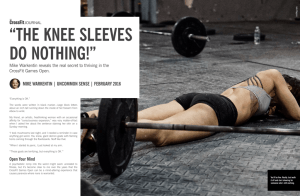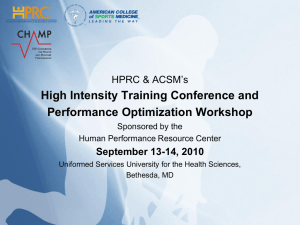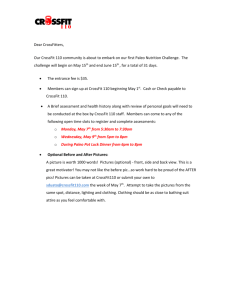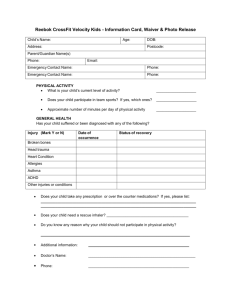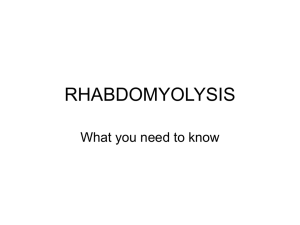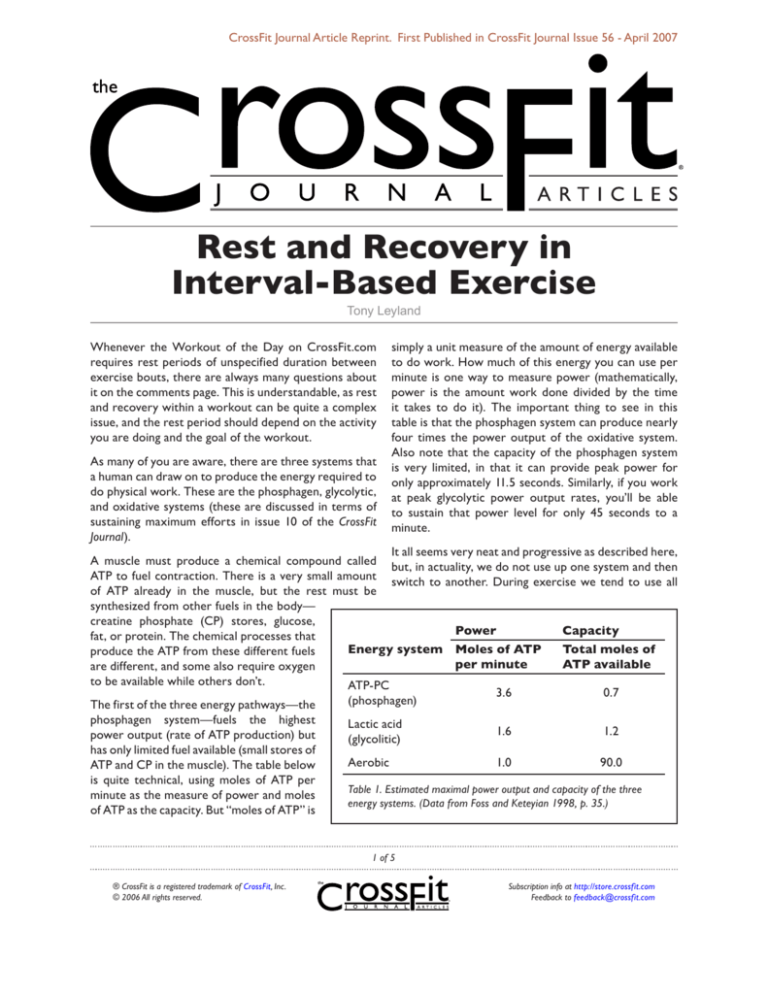
CrossFit Journal Article Reprint. First Published in CrossFit Journal Issue 56 - April 2007
Rest and Recovery in
Interval-Based Exercise
Tony Leyland
Whenever the Workout of the Day on CrossFit.com
requires rest periods of unspecified duration between
exercise bouts, there are always many questions about
it on the comments page. This is understandable, as rest
and recovery within a workout can be quite a complex
issue, and the rest period should depend on the activity
you are doing and the goal of the workout.
As many of you are aware, there are three systems that
a human can draw on to produce the energy required to
do physical work. These are the phosphagen, glycolytic,
and oxidative systems (these are discussed in terms of
sustaining maximum efforts in issue 10 of the CrossFit
Journal).
simply a unit measure of the amount of energy available
to do work. How much of this energy you can use per
minute is one way to measure power (mathematically,
power is the amount work done divided by the time
it takes to do it). The important thing to see in this
table is that the phosphagen system can produce nearly
four times the power output of the oxidative system.
Also note that the capacity of the phosphagen system
is very limited, in that it can provide peak power for
only approximately 11.5 seconds. Similarly, if you work
at peak glycolytic power output rates, you’ll be able
to sustain that power level for only 45 seconds to a
minute.
It all seems very neat and progressive as described here,
A muscle must produce a chemical compound called but, in actuality, we do not use up one system and then
ATP to fuel contraction. There is a very small amount switch to another. During exercise we tend to use all
of ATP already in the muscle, but the rest must be
synthesized from other fuels in the body—
creatine phosphate (CP) stores, glucose,
Power
Capacity
fat, or protein. The chemical processes that
Energy system Moles of ATP
Total moles of
produce the ATP from these different fuels
per minute
ATP available
are different, and some also require oxygen
to be available while others don’t.
ATP-PC
3.6
0.7
(phosphagen)
The first of the three energy pathways—the
phosphagen system—fuels the highest
Lactic acid
1.6
1.2
power output (rate of ATP production) but
(glycolitic)
has only limited fuel available (small stores of
Aerobic
1.0
90.0
ATP and CP in the muscle). The table below
is quite technical, using moles of ATP per
Table 1. Estimated maximal power output and capacity of the three
minute as the measure of power and moles
energy systems. (Data from Foss and Keteyian 1998, p. 35.)
of ATP as the capacity. But “moles of ATP” is
of 5
® CrossFit is a registered trademark of CrossFit, Inc.
© 2006 All rights reserved.
Subscription info at http://store.crossfit.com
Feedback to feedback@crossfit.com
Rest and Recovery in Interval-Based Exercise (continued...)
three (except during low-power-output efforts that can
be sustained for 60 minutes or more, which use the
oxidative system pretty much exclusively). The table
below shows the approximate percentage contribution
of each of the systems for maximal power outputs
of different time durations. For example, if I work at
a power output that I can sustain for only 30 seconds
before reaching fatigue (and hence a reduction in power
output), approximately 65 percent of the energy would
be supplied by the glycolytic system over those 30
seconds.
on this topic and there is some disagreement on the
right way to classify muscle fibers. So I am going to
simplify things considerably here. There are three types
of fibers:
• Type 2b fast-twitch fibers are recruited for very
short duration high intensity bursts of power such
as maximal and near-maximal lifts and sprints.
These fibers produce high force levels quickly but
they fatigue quickly also.
• Type 2a fast-twitch fibers are more fatigue-resistant
than type 2b fibers but cannot produce
force quite as rapidly. They are used
Duration of
% Phosphagen
% Glycolitic
% Oxidative
more in sustained power activities like
power output
sprinting 400m or doing repeated lifts
5 seconds
85
10
5
with a weight below your maximum (but
10 seconds
50
35
15
not very light weights).
30 seconds
15
65
20
• Type 1 slow-twitch fibers are used
60 seconds
8
62
30
in lower intensity exercises like light
resistance work aimed at muscular
2 minutes
4
46
50
endurance and long duration aerobic
4 minutes
2
28
70
activities like running 5K and 10K.
10 minutes
1
9
90
So now you have a sense of what energy
30 minutes
negligible
5
95
system and muscle fibers you are using,
60 minutes
negligible
2
98
how long you should recover between
exercise bouts? The answer depends on
120 minutes
negligible
1
99
which energy system you are stressing
Table 2. Approximate percentage contribution of the three energy systems during and the purpose of your training that day.
maximal power outputs of varying durations.
This is why rest periods are not always
Table adapted from McArdle, Katch, & Katch 1996; Williams & Wilkins 1996, p. specified in exact terms in the WOD.
129; and National Coaching Certificate Program 1990.
I will often ask my students on an exam, “If you got
up and walked across the room for 10 seconds, what
energy system would you predominantly use?” The
answer is the oxidative system, because the power
output is so low when I walk that I could sustain that
power output for hours and hours. But if I asked “If
you sprinted all-out for 10 seconds, what energy system
would you predominantly use?” the answer would be
the phosphagen system. So although time is shown on
the left side of the table above, you must realize that it is
really power output that determines the energy systems
used (and high power output—aka intensity—cannot
be sustained over long periods).
Before we discuss rest periods I should also mention
muscle fiber types. Numerous books have been written
Let us start by looking at the WOD that
requires three 800-meter sprints. Let
us assume each 800-meter effort will take the athlete
three minutes. We can estimate (from the data in Table
2, above) that around 40 percent of the energy required
for each 800 meters will come from the anaerobic
systems (mostly the glycolytic system and a small amount
from the phosphagen system). Because of this reliance
on the glycolytic system, an 800-meter run produces a
considerable amount of lactic acid accumulation in the
primary muscles involved in the run, and if you attempt
to run again too soon, not enough of this lactic acid will
have been cleared from the muscles. If the accumulation
of lactic acid gets too high, the increased acidity in the
muscle is going to result in local muscle fatigue and the
muscles affected will start to lose power (i.e. contractile
force) and coordination, which will directly affect your
performance. Remember that lactic acid can be used
of 5
® CrossFit is a registered trademark of CrossFit, Inc.
© 2006 All rights reserved.
Subscription info at http://store.crossfit.com
Feedback to feedback@crossfit.com
Rest and Recovery in Interval-Based Exercise (continued...)
as a fuel only if sufficient oxygen is available. If enough
oxygen is available, as it will be when you are resting
between efforts, the lactic acid will be either used for
energy in the recovery process or resynthesized back
into glycogen.
So how long should you wait before the next sprint?
Table 3 shows that the rest could be as little as three
minutes (a 1:1 work to rest ratio) or as long six minutes
(a 1:2 ratio). If you are a really fast 800-meter runner
(around two minutes), you may even use a 3:1 work
to rest ratio and rest six minutes. Why such a range?
Well, if you really want to develop a sense of a fast 800meter pace and want to get to your best times for each
exercise interval, then you need a longer rest. If you
just want to run reasonably fast (but not close to your
best possible 800-meter effort) and want to increase
your ability to tolerate high levels of lactic acid, then you
could rest closer to the 1:1 ratio.
the lactic acid and allow the muscles to restore enough
fuel for the next run. If you ran 800 meters in 2:30 and
then rested only one minute before going again, you
wouldn’t be able to maintain that time on your second
effort (assuming that the initial 2:30 pace was fast for
you). The second and third efforts would be slower and
therefore rely more and more on the oxidative system.
The muscle fibers used would also be affected as the
muscles your body would prefer to be active during a
fast 800m are fatigued and cannot contribute as much in
the second and third runs. So you really do change the
effect of the exercise bout by not having an appropriate
rest interval.
As an additional point, I should explain that the best
type of recovery from exercise bouts that produce lots
of lactic acid is light work or “active” rest. By this I mean
that if you sprint a distance of 400 to 1,000 meters
and finish with high levels of lactic acid accumulation
in your leg muscles, you should jog
slowly during the recovery time. (This
Range of
is what is termed a work-relief cycle.)
Approximate
Primary
Typical
exercise-toThe easy jogging will help maintain good
% of maximum energy system exercise
rest period
blood flow to and from the muscles and
power
stressed
duration
ratios
therefore contribute to the removal of
lactic acid. When recovering from work
90-100
Phosphagen
5-10 seconds
1:12 to 1:20
that predominantly uses the phosphagen
75-90
Glycolytic
15-30 seconds
1:3 to 1:5
or oxidative system (and hence does not
Glycolytic and
produce much, if any, lactic acid), you can
30-75
1-3 minutes
1:2 to 1:4
oxidative
just rest.
20-35
Oxidative
>3 minutes
1:1 to 1:3
Now let us think about a recent WOD
Table 3. Work-to-rest ratios for various exercise durations.
that required ten100-meter sprints.
One of the first posts to the CrossFit
Adapted from Baechle and Earle 2000, p. 88.
comments page asked if 30 seconds
between sprints was adequate. This
What happens if you shorten the rest interval below is far too short. If you rested only 30 seconds, your
the 1:1 ratio? Well, to help explain, let us take things to performance would drop off and you would be running at
an illogical extreme. If we ran all three exercise bouts a 400-meter pace or slower by the end of the workout.
together and did a single 2.4-km distance, let’s say it So instead of sprinting 100 meters and predominantly
would take approximately 10 minutes. But what is the stressing the phosphagen system and type 2b muscle
workout about now? It becomes an aerobic workout, fibers, you would be running at a pace that stresses the
with approximately 90 percent of the energy being glycolytic system and probably more type 2a muscle
supplied by the oxidative system (table 2), involving fibers. So you would have changed the nature of the
mostly slow-twitch muscle fibers.
workout completely.
Now, that was illogical (the zero rest period), but
hopefully the example made it clear that you change
the nature of the workout when you change the rest
interval. What if I rested only one minute between 800meter sprints? It wouldn’t be enough time to remove
Table 3 shows that if you are taking 12 seconds to sprint
that 100 meters, you should rest anywhere from 140
to 240 seconds (work/rest ratios 1:12 to 1:20). If you
are really producing maximal efforts, I would suggest
extending the rest period to the higher end of this
of 5
® CrossFit is a registered trademark of CrossFit, Inc.
© 2006 All rights reserved.
Subscription info at http://store.crossfit.com
Feedback to feedback@crossfit.com
Rest and Recovery in Interval-Based Exercise (continued...)
range and beyond. Elite sprinters may wait five minutes
or more between attempts at really fast 100-meter
times. This seems like a long time. However, you cannot
rush this process, as local muscle fatigue is related to
factors that limit the ability to perform muscular work.
These include the energy systems I’ve discussed, the
accumulation of metabolic byproducts (such as lactic
acid); and the failure of the muscle fiber’s contractile
mechanisms. For example, the replenishment of
muscle phosphagen stores takes two to three minutes,
depending on the duration of the high-intensity interval.
And the many chemicals and structures that are involved
in the contractile process also have to recover. Simply
put, you cannot rush the chemistry involved. (While,
over time, training does increase your physiological
capacity for both work and recovery, there are limits on
the speed of the chemical reactions involved in recovery.
At any given fitness level, the biological processes can’t
be overcome merely by force of will.)
There is also the issue of central nervous system
(CNS) fatigue. Neurotransmitters are involved in
communication within the brain and between the brain
and the rest of the body. During intense repeated
bouts of strenuous exercise, these neurotransmitters
get depleted, which results in reduced physical and
cognitive performance. In the past, research has focused
primarily, if not exclusively, on fatigue at the muscular
level, in part because it is not easy to study the brain
and CNS. However, research using new brain imaging
technologies is starting to give us a better understanding
of the relationship between voluntary effort from the
brain and force output from the muscle. All voluntary
muscle activities are controlled by the CNS through the
nerve connections. Hence CNS fatigue is an integral
part of rest/recovery cycles during exercise bouts.
Unfortunately, much more research is needed, but we
do know neurotransmitter depletion can cause CNS
fatigue, reduced motivation, loss of motor control,
and can even affect memory. And in true CrossFit
fashion, regardless of academic research, we can look
at specialist sprinting and weightlifting coaches and copy
the recovery times they have come to recommend
based on trial and error with thousands of athletes.
To summarize, if you do not get enough rest after
periods of high-intensity exercise, you will not have the
right fuel available to power your efforts, your muscle
fibers and CNS will be fatigued, and you will have to
shift to a slower energy system and type 2a or even
slow-twitch muscle fibers to get the job done. But the
job will have to be done with less weight or slower sprint
times—in other words, at lower power outputs. There
is also evidence that your coordination will be affected,
which will further reduce your effective application of
power.
If you are still wary of waiting three to five minutes
between 100-meter sprints, think about how long you
wait between attempting a set of lifts working up to
a personal best attempt? For example, on Saturday,
March 10, 2007, the WOD was: Split Jerk 3-2-2-2-11-1-1-1 reps. How long would an athlete wait before
attempting these lifts for a one-repetition maximum
or near-maximum? How long do you wait between the
final attempts of one-repetition maximums when doing
the CrossFit Total? Research suggests a minimum of
three minutes rest between loads in the one- to threerep maximum range. This probably wouldn’t surprise
those used to attempting one-rep maxes in their weight
training. In the benchmark workout “Lynne” (five
rounds for max reps of bodyweight bench press and
pull-ups), each round is repeated every five minutes.
However, many of these same athletes do not seem to
view maximal-effort short-distance sprints in the same
category as maximal lifts. They should though (and next
month I plan to further discuss this and peak power
efforts).
As coincidence would have it, I had already submitted
this article when I saw that the WOD for Monday,
March 19, 2007, was to run 400 meters four times with
two minutes of rest rounds. Is this a long enough rest?
It depends on the purpose of the workout. If you are
sprinting maximally—and really trying to get your best
time on each round—it isn’t, as the rest to work ratio is
only between 1:1 and 1:2 for those fast sprinters. Some
of the results posts for that day that show fast times
(65 to 80 seconds) show considerable drop-off between
the first sprint and the fourth. (Keep in mind that 70
seconds dropping to 77 seconds is a 10 percent decline.
Quite significant.) This shows that those athletes hadn’t
cleared enough lactic acid, had fatigued muscle fibers,
and probably had some CNS fatigue. However, some of
those who posted less fast times were able to repeat
all four runs in the same time. This is simply because
those with slower times were not truly pushing 100
percent and thus were leaving “something in the tank”
(intentionally or not). This is why interval training is
quite complex. You can run 400 meters at a slightly
of 5
® CrossFit is a registered trademark of CrossFit, Inc.
© 2006 All rights reserved.
Subscription info at http://store.crossfit.com
Feedback to feedback@crossfit.com
Rest and Recovery in Interval-Based Exercise (continued...)
faster pace than your 5k pace and use it to work on
pacing and your running endurance. In this case, you
will not finish with high levels of accumulated lactic acid
and you can run again relatively quickly (possibly with
less than a two-minute rest interval). On the other
hand, you can run the 400 meters as fast as possible and
attempt to run each of the next three in the same time,
but you would have to rest for periods in the 1:2 to 1:4
range (see table 3). As stated at the beginning it does
depend on the goals of that workout for that day and, in
true CrossFit fashion, you can do this kind of workout
in either way and reap varied gains from it.
One of the most common errors for many specialized
athletes, both distance runners and lifters, both
beginners and advanced, is overtraining. Lured by the
“more is better” mantra, many seem to think that if
we train longer, harder, and more often, we’ll get the
best possible results. I have seen posts on the CrossFit
website on rest day in which people say they don’t want
to rest and so they did another workout. This is an error.
I think people sometimes make similar errors within
the WOD. Can less be better? Well, fewer repetitions
per work set and longer rest periods might mean a
reduced average power output over the duration of
the workout. But the peak power you attain and the
number of exercise periods where you can reach this
peak power will be higher. And that is a good thing.
Studies and texts cited in this
article
Baechle, T.R., and E.W. Earle, eds. 2000. Essentials
of Strength Training and Conditioning. 2nd ed.
Champaign. IL: Human Kinetics.
Foss, M.L., and S.J. Keteyian. 1998. Fox’s Sports
Physiology. 6th ed. Boston: WCB McGraw-Hill.
McArdle, W., F. Katch, and V. Katch. 1996.
Exercise Physiology. 4th ed. Baltimore: Williams
& Wilkins.
National Coaching Certificate Program. 1990.
Coaching Theory Level 3. Course conductor
video. Ontario: Coaching Association of
Canada.
Tony Leyland is Senior Lecturer at the School of Kinesiology, Simon Fraser University, in Vancouver, Canada.
He has taught at the university level for 24 years and has been heavily involved in competitive sports such
as soccer, tennis, squash, and rugby as both an athlete and a coach for over 40 years. He is a professional
member of the National Strength and Conditioning Association, a Canadian National B-licensed soccer
coach, and a level-1 CrossFit trainer.
of 5
® CrossFit is a registered trademark of CrossFit, Inc.
© 2006 All rights reserved.
Subscription info at http://store.crossfit.com
Feedback to feedback@crossfit.com

